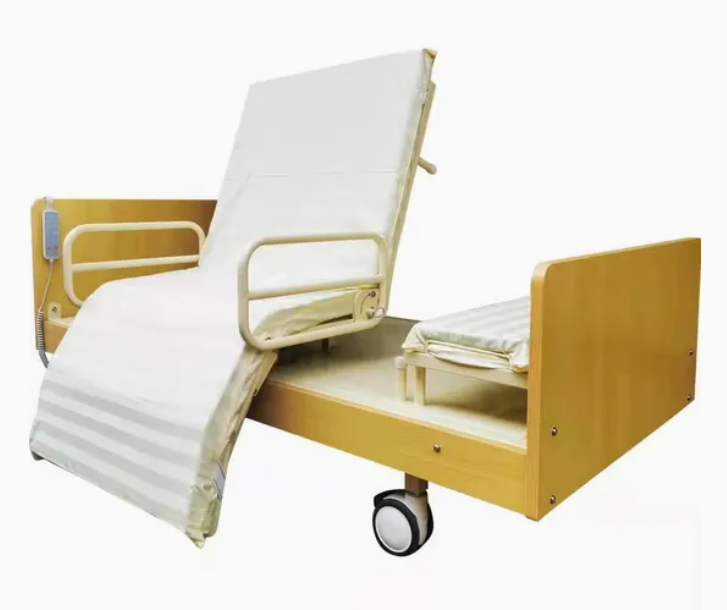How to select a hospital bed for mobility needs? If you’re caring for someone or planning for the future, focus on comfort, safety, and independence. Have you considered how adjustable features or built-in lift options could help? There’s one important factor that often gets overlooked…
Factors to Consider in Selecting a Hospital Bed for Mobility Needs
When choosing a hospital bed for mobility needs, it’s important to think about factors that ensure the patient’s comfort, safety, and independence.
Adjustability for Mobility Assistance
Beds with adjustable height and positioning options are essential for patients who need help getting in and out of bed. These features make it easier for people with limited mobility to move in and out of bed safely and comfortably.
Integrated Lift Chair Features
Beds with built-in lift chair features are great for those with severe mobility limitations. These beds allow the head and foot of the bed to rise, helping the patient sit up, lie down, or change positions on their own. This reduces the need for caregiver help and increases comfort.
Positioning Features for Comfort and Health
Beds with adjustable head, foot, and knee positions are necessary for patients with mobility issues. These adjustments help prevent pressure sores and improve overall comfort.
Easy Transfer Options
For patients who can’t move on their own, it’s important to select beds that make transfers easier. Beds with powered lifts or manual slings help caregivers shift patients into sitting or sideways positions, making transfers safer.
Low Beds for Fall Prevention
Low hospital beds are closer to the ground, reducing the risk of injury if a patient falls. This is especially important for patients who are at risk of falling out of bed. Adding bed rails can further prevent falls and enhance safety.
Electric vs. Manual Adjustment
If the caregiver doesn’t have the strength to use a manual crank, consider an electric hospital bed. These beds adjust with the push of a button, making it easier for caregivers and offering convenient adjustments for the patient.
Safety Features for Injury Prevention
Hospital beds with side rails, brake systems, and emergency controls are vital for preventing falls and other injuries. These features should be a top priority to keep the patient safe.
Compatibility with Care Accessories
Make sure the bed works well with essential accessories like IV poles, overbed tables, and patient lifts. These can help improve mobility and provide better care for the patient.
Key Features of Hospital Beds for Mobility
When choosing a hospital bed for mobility, consider key features that improve comfort, independence, and safety.
Adjustable Height and Positioning
A hospital bed’s ability to adjust its height, backrest, and leg elevation is one of the most important features. This flexibility helps users find the most comfortable positions, improving circulation and reducing pressure points. High-low elevation is also important for patients who use mobility aids like canes, walkers, or wheelchairs. It makes transfers easier and allows patients to keep their feet flat on the floor when standing.
Sturdy Side Rails and Safety Measures
For safety, side rails offer support and prevent falls, especially for patients with limited mobility. Some beds also include braking systems and anti-trap mechanisms for added protection and stability during transfers.
Tilt and Trendelenburg Positions
Beds that can tilt or adopt a Trendelenburg position help caregivers reposition patients and reduce the physical strain of transfers. These positions minimize the risk of injury and increase comfort for both patients and caregivers.
Adjustable Frames and Hand Controllers
For patients who cannot adjust themselves in bed, adjustable frames with hand controllers are essential. This feature makes it easier for caregivers to reposition patients, improving comfort and reducing the risk of bedsores. For patients with more severe paralysis, joystick controls with chin cups offer extra support and ease of use.
Specialized Mattresses and Cushions
Hospital beds can come with specialized mattresses, overlays, and cushions that help prevent pressure ulcers. These features provide therapeutic support and ensure proper positioning for individuals who spend extended periods in bed.
Bed-Wheelchair Integration
Some hospital beds integrate with wheelchair mechanisms. A good example is the Phase II modified conventional hospital bed, which can function as both a hospital bed and a wheelchair. This dual-purpose design includes motorized knee and back elevation, as well as a foldable steel frame, making it easy to move.
Checklist for Selecting a Hospital Bed for mobility needs
When choosing a hospital bed for mobility needs, consider the following factors:
- Mobility Level & Medical Needs: If the person needs frequent repositioning, I recommend an adjustable hospital bed with motorized features.
- Mobility Issues: Pick a bed with adjustable frames and hand controllers. Bed rails and side assist rails are important for preventing falls.
Hospital Bed Size and Weight Capacity
- Size Options: Choose between standard, bariatric, or twin-sized beds, depending on the user’s needs and the available space. Larger beds may be necessary for those who need more room.
- Weight Capacity: Make sure the bed can support the user’s weight. Bariatric beds are built with reinforced frames to handle higher weight capacities.
Adjustability Features
- Height, Head, and Foot Adjustability: Adjustable beds are great for comfort, preventing bedsores, and improving circulation. Electric beds are easy to adjust with remote controls, while semi-electric options offer manual adjustments.
Safety Features
- Side Rails: These are important for preventing falls, especially for individuals with limited mobility.
- Locking Wheels: Ensure the bed stays in place and doesn’t move unexpectedly.
- Bed Alarms: Bed alarms are helpful for high-acuity patients, alerting caregivers to prevent falls.
Ease of Transfers and Caregiver Assistance
- High-Low Elevation: This feature helps people using mobility aids like wheelchairs or canes, making transfers easier.
- Adjustable Height: Beds that adjust to the right height reduce strain on caregivers during patient transfers.
Bed Types
- Manual, Semi-Electric, or Fully Electric: Fully electric beds are ideal for patients who need frequent adjustments. Semi-electric beds offer a mix of manual and electric controls.
Fit in the Room
- Space Considerations: Make sure the bed fits comfortably in the room, leaving enough space for caregivers to move around.
By keeping these factors in mind, you can choose the best hospital bed to meet the user’s mobility needs, ensuring comfort and safety.
Grace Medy specializes in the production of hospital beds. The hospital beds they produce have height adjustment functions, chair function, electric control function, etc. They can well meet the mobility needs of patients. They not only provide hospital beds, but also provide a variety of hospital furniture, including hospital chairs, operating tables, shadowless lights, emergency trolleys, wheelchairs, walking aids, etc.
Summary
Choosing the right hospital bed manufacturer and right hospital bed for mobility needs is crucial for comfort, safety, and independence. Consider all the key features to provide the best care for your loved ones or patients. The right bed helps both patients and caregivers experience less stress and greater peace of mind. Focus on the individual’s needs, and you’ll make a choice that improves their quality of life.


